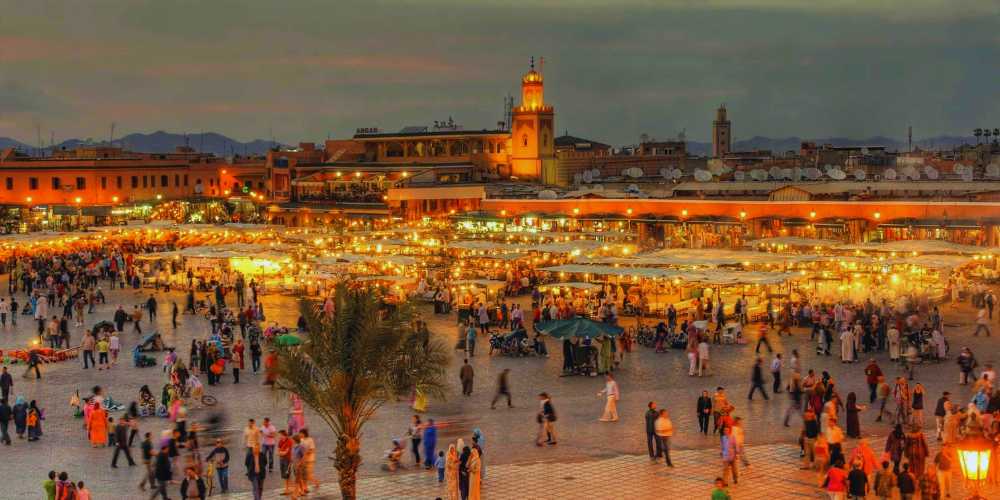Marrakech is the colorful and bustling heart of Morocco, and souks are said to be indeed the very essence of life here. The winding alleyways, the aroma of spices wafting in the air, the sound of bargaining voices, and the bright hues of hand-crafted wares define the spirit of Marrakech. The souks of the city are not merely places of barter; they represent cultural landmarks, storytelling centers, and living museums of the Moroccan way of life. In this in-depth study, we would like to unravel why Marrakech is a city where souks are associated with said to pertain to everything occupying this planet: culture, craftsmanship, food, and entertainment.
The Historic Significance of the Souks in Marrakech
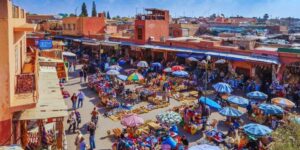 The souks of Marrakech are a few centuries old, thereby having immense importance in the economic and cultural evolution of the city. Historically, Marrakech had been one of the prominent trading posts along the trans-Saharan caravan routes, attracting merchants from Africa, the Middle East, and Europe. This is a tradition that survives into the present, where souks are associated with from tradition, Marrakech is meanwhile a city of global trade. While walking through the Medina, one might still feel the echoes of a bygone age, where traders once exchanged goods, ideas, and tales within these bustling markets.
The souks of Marrakech are a few centuries old, thereby having immense importance in the economic and cultural evolution of the city. Historically, Marrakech had been one of the prominent trading posts along the trans-Saharan caravan routes, attracting merchants from Africa, the Middle East, and Europe. This is a tradition that survives into the present, where souks are associated with from tradition, Marrakech is meanwhile a city of global trade. While walking through the Medina, one might still feel the echoes of a bygone age, where traders once exchanged goods, ideas, and tales within these bustling markets.
Where Souks Are Associated With Craftsmanship
Marrakech is the home of artisans who have kept ancient techniques alive through generations. The souks are divided into special parts; you can find there an exquisite carpet and hand-woven textiles, as well as hundreds of ornamental metal works or fine leather goods. For instance, the Souk Chouari is dedicated to woodwork and handmade furniture, while that of Souk Haddadine portrays the masters at work, blacksmiths shaping iron into piece-de-resistance decorative elements. These markets clearly show how Marrakech still is a city where souks are associated with the preservation of craft and art
Magic in Jemaa el-Fnaa: Where Entertainment Meets Souks
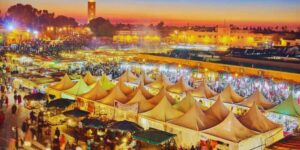 Jemaa el-Fnaa, the famous square of Marrakech, stands as the heart of the city’s souk culture. As the sun sets, this hustling square becomes a stage for storytellers, musicians, and acrobats to work their magic on the audiences. Where souks are associated with centers of commerce by day, Jemaa el-Fnaa shows us the importance of this space as a center of entertainment and social interaction at night. Here, visitors bear witness to the mesmerizing oral traditions of Marrakech, where the legends of sultans and gallant adventurers get a new life by the flickering of century-old lanterns.
Jemaa el-Fnaa, the famous square of Marrakech, stands as the heart of the city’s souk culture. As the sun sets, this hustling square becomes a stage for storytellers, musicians, and acrobats to work their magic on the audiences. Where souks are associated with centers of commerce by day, Jemaa el-Fnaa shows us the importance of this space as a center of entertainment and social interaction at night. Here, visitors bear witness to the mesmerizing oral traditions of Marrakech, where the legends of sultans and gallant adventurers get a new life by the flickering of century-old lanterns.
Culinary Delights: Where Souks Are Associated With Food Culture
Marrakech, being a food lover’s paradise, has built the treasure house of its souks in its food. From the most sumptuous aromatic spices of fresh and mouth-watering fruits, street foods all find their way into the bustling markets of food. The air of saffron, cumin, cinnamon, and ras el hanout shape intoxicating scents in spice souks across the city-a city deep in its deep culinary heritage.
Savored dish on offer would be tagine-some slow-cooked stew prepared with local spices, or ceremonial sweet items such as chebakia that is made with lots of honey-drenched pastry. Apart from ingredients, other food stalls on Jemaa el-Fnaa serve some of the best grilled meats and harira soup and so make Marrakech a city where souks are associated with gastronomy at its finest.
Hidden Gems: Lesser-Known Souks of Marrakech
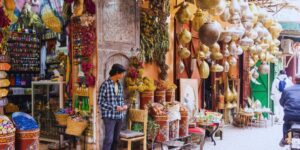
Although many travelers explore the large souks near the Medina, the city of Marrakech has several lesser-known markets for a more intimate experience. The Souk des Teinturiers, or Dyers’ Souk, is where visitors can witness the artisans dyeing wool in various bright colors using ancient techniques. The Mellah, the old Jewish quarter, is yet another engaging area where souks are associated with feed into antique treasures, vintage jewelry, and the historic remnants of Jewish craftsmanship.
The Secret Ritual of Bargaining: The Souks in the Collectivization of Social Exchange
As far as bargaining is concerned, one will experience it in the souk of Marrakech. More than just trading, it is a social ritual, and a negotiation choreography between buyer and seller. The haggling is an art, needing patience, respectfulness, and camaraderie. The busy activity that goes on around merchants allows visitors to relate with them, appreciate and understand the value of handcrafted goods, and really learn about several aspects of culture concerning souk trade. This is where souks are associated with become economic again, for they are more than just spaces of economic transactions; they are also spaces of human connections and respect toward the other.
Luxury Meets Tradition: Boutique Souks and Riads
Boutique souks have emerged in Marrakesh, for now, a special feature in between affluence and tradition. This goes from la Maison de la Photographie to the busy busy souks of La Mamounia-all express a rather upscale shopping experience tied to the essence of Moroccan craftsmanship-rich culture associated with suks for historical trade-these new interpretations exemplify how suks are continuing to have roots in tradition while thriving.

Most riads, traditional yet so existent of souk culture, now have certain selective shopping in their lovely courtyards. Guests staying in these beautiful transformed guesthouses can discover exclusive collections of handcrafted items without having to get into a chaotic Medina. This is how a unique blend of old and new makes Marrakesh a city where souks are associated with be counted on for timeless elegance and innovation.
Day Trips and Beyond: Exploring the Markets of the Atlas Mountains
While the souks of Marrakech are world-renowned, the area surrounding it holds even more captivating market experiences. Journeying to Ourika Valley on a day trip is an opportunity to witness the weekly souks in the Berber villages, where villagers barter farm animals, raw produce, and handmade crafts. The souks in these remote villages offer a better view of Morocco’s rural traditions, proving that Marrakech’s culture goes well beyond its city walls.
The Future of Marrakech’s Souks: Balancing Tradition and Modernity
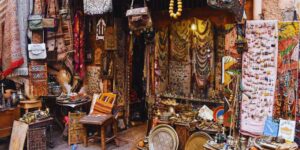
As Marrakech continues to forge itself into an international tourist destination, the souks face another challenge: the balancing act of tradition with modernity. To conserve the cultural heritage of the city above all: encourage, though, sustainable tourism and fair, ethical handiwork. The initiatives promoting fair trade, eco-friendly materials, and local artisan cooperatives are on the rise, making sure that Marrakech is still associated with a place where souks are associated with become responsible and conscious travel.
Conclusion: A City Where Souks Are Associated With Life Itself
Marrakech is not merely a place one can visit; it is something that stays with you long after your departure. The souks of the city represent culture-they embody history, handicrafts, food, and social traditions. Whether you are meandering through the vividly painted alleys of the Medina, bargaining for a handmade rug, or simply relishing a bowl of hot harira, it subconsciously dawns upon you that Marrakech is a city where souks are associated with synonymous with life itself. A city that borders between times, where every street tells a story, and each visitor becomes part of its ever-growing palimpsest; for a genuine Moroccan experience, head straight to Marrakech, where souks are associated with synonymous with the very essence of existence.

